
Mozambique Prepares for Cholera after Cyclone Wreaks Havoc
Rescue teams in Mozambique moved hundreds of people displaced by Cyclone Idai’s massive and deadly flooding to safer shelters on Monday, while the government made preparations for a cholera outbreak that it says is inevitable amid the devastation. In areas west of the port city of Beira, hundreds of people were trapped for more than […]

Rescue teams in Mozambique moved hundreds of people displaced by Cyclone Idai’s massive and deadly flooding to safer shelters on Monday, while the government made preparations for a cholera outbreak that it says is inevitable amid the devastation.

In areas west of the port city of Beira, hundreds of people were trapped for more than a week after Idai hit, surviving in vast tracts of submerged land with no access to clean water and shrinking food supplies.
Water has been slowly receding and there was no rain in Beira on Monday, meaning some roads have become passable. But the size of the disaster zone means getting aid to the most needy is still difficult.


“We are more organized now, after the chaos that we’ve had, so we’re delivering food and shelter to more people today,” Land and Environment Minister Celso Correia told reporters.
The number of people in makeshift camps had risen by 18,000 to 128,000 since Sunday, he said, adding that the government would install a prevention and treatment centre for cholera in areas affected by the cyclone.
“We have a lot of diarrhoea, but teams are working on the ground to say whether it is really cholera or not. But as I said there will be cholera,” Correia said.

In Buzi village, southwest of Beira, Reuters reporters saw hundreds of cyclone victims carrying their few possessions on their heads as they were moved to a displacement centre near the airport, where aid agencies have set up tents with access to drinking water.
Idai lashed Beira with winds of up to 170 kph (105 mph) on March 14, then tore inland through Zimbabwe and Malawi, flattening buildings and killing at least 661 people across the three countries.
United Nations aid chief Mark Lowcock said on Monday that the world body was appealing for $282 million to fund a response to the disaster in Mozambique for the next three months. This would cover relief including health, water and sanitation, he told reporters.
“Mozambique is, we think, the worst hit, but there are very real needs in the other countries as well,” said Lowcock, adding that appeals for Zimbabwe and Malawi would be launched in the coming days.
LOSING EVERYTHING
The scale of the disaster has meant aid has been slow to arrive. Communities near Nhamatanda, around 100 km northwest of Beira, were due to receive assistance on Monday. On Sunday inhabitants of poor farming communities in that area told Reuters their food had run out and rescuers were yet to reach them.

Aid workers distributed maize meal in the Chipinge district of eastern Zimbabwe, where there was no power or piped water.
“We lost all our perishables after Cyclone Idai,” Chipinge resident Kudakwashe Mapungwana said. “Since then we have no electricity at all and women are busy buying charcoal which is very expensive.”
Correia said the death toll in Mozambique remained roughly unchanged at 447 on Monday. In Zimbabwe the government says the storm has killed at least 154 people.
In Malawi, the death toll from torrential rains and flooding, some of which occurred before the cyclone hit, had risen to 60 from 56, a spokesman at the Ministry of Homeland Security said. The government was sending relief items by train and truck, he said.
The death toll in Mozambique could rise steeply as receding floodwaters allow rescuers to access remote areas or if waterborne diseases like cholera gain a foothold.
Cholera is spread by faeces in sewage-contaminated water or food, and outbreaks can develop quickly in a humanitarian crisis where sanitation systems are disrupted. It can kill within hours if left untreated.


The secretary general of the International Federation of Red Cross and Red Crescent Societies (IFRC) said after a visit to Mozambique that the situation there was a “ticking bomb” as regards waterborne diseases.
Elhadj As Sy said: “I’m raising that alarm because so many of these waterborne diseases are a great risk but they are preventable.”
(Additional reporting by Stephen Eisenhammer, Siphiwe Sibeko, Maria Vasilyeva and Yvonne Bell in Beira, Philimon Bulawayo in Chipinge and MacDonald Dzirutwe in Harare, Frank Phiri in Blantyre, Tom Miles in Geneva, Michelle Nichols at the United Nations; Writing by Alexander Winning; Editing by Hugh Lawson, Andrew Heavens and Frances Kerry)
****
Hundreds of thousands of people are in need of food, water and shelter after Cyclone Idai battered Mozambique, Zimbabwe and Malawi.

As of Monday, at least 661 people had been reported killed by the storm, the flooding it caused and heavy rains before it hit. Following is an outline of the disaster, according to government and United Nations officials:
MOZAMBIQUE
Cyclone Idai made landfall the night of March 14 near the port city of Beira, bringing heavy winds and rains. Two major rivers, the Buzi and the Pungue, burst their banks, submerging entire villages and leaving bodies floating in the water.
Number killed: 447
Number injured: 1,500
Houses damaged or destroyed: 33,600
Crops damaged: 500,000 hectares
Number affected: 531,000
ZIMBABWE
On March 16, the storm hit eastern Zimbabwe, where it flattened homes and flooded communities in the Chimanimani and Chipinge districts.
Number killed: at least 154, according to government. U.N. migration agency puts toll at 259.
Number injured: 200
Number displaced: 16,000 households
Number affected: 250,000
MALAWI
Before it arrived, the storm brought heavy rains and flooding to the lower Shire River districts of Chikwawa and Nsanje, in Malawi’s south. The rains continued after the storm hit, compounding the misery of tens of thousands of people.
Number killed: 60
Number injured: 672
Number displaced: 19,328 households
Number affected: 868,895
(Reporting by Emma Rumney in Beira, Tom Miles in Geneva, MacDonald Dzirutwe in Harare and Frank Phiri in Blantyre; Writing by Alexandra Zavis; Editing by Louise Heavens, Andrew Cawthorne and Frances Kerry)
